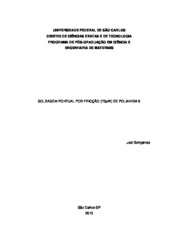| dc.contributor.author | Gonçalves, Joel | |
| dc.date.accessioned | 2016-09-21T12:40:37Z | |
| dc.date.available | 2016-09-21T12:40:37Z | |
| dc.date.issued | 2015-08-03 | |
| dc.identifier.citation | GONÇALVES, Joel. Soldagem pontual por fricção (FSpW) de poliamida 6. 2015. Dissertação (Mestrado em Ciência e Engenharia de Materiais) – Universidade Federal de São Carlos, São Carlos, 2015. Disponível em: https://repositorio.ufscar.br/handle/ufscar/7314. | * |
| dc.identifier.uri | https://repositorio.ufscar.br/handle/ufscar/7314 | |
| dc.description.abstract | Friction Spot Welding (FSpW) is an innovative technique developed and
patented in 2005 by the Helmholtz Zentrum Geesthacht (HZG) research center
in Germany. FSpW uses the friction between a rotating tool and the workpieces
to generate heat enough to cause diffusion across the interface to consolidate
the weld. This new welding technology has been tested and optimized with the
objective of produce overlap weld joints between two polyamide 6 plates. Full
factorial design of experiments (24) and analysis of variance (ANOVA) allowed
to explain the effects of weld parameters as rotational speed (RS), welding time
(WT), plunge depth (PP), holding pressure time (HPT) and the interactions
between these main parameters on the microstructural characteristics and
mechanical strength of the joints. The rotational speed (RS) and welding time
(WT), within the limits studied, had greater influence on the mechanical single
lap shear strength of the joints that achieved up to 26 MPa. This behavior was
related to the higher heat generation during the weld, reaching temperatures of
up to 275°C, thereby increasing the welded area. The parameter holding
pressure time (HPT), designed in this study allowed the cooling and
solidification of the polymer under pressure, improving the weld surface
finishing and avoiding defects as voids in the weld area. The most common
failure for the joints with higher mechanical strength was the fracture of one of
the plates while the joints with lower mechanical strength showed interface
shear failure. The degree of crystallinity of PA6 in the welded area did not show
a significant difference as compared to the base material. The molecular weight
of PA6 in the welded area was reduced in the worst case 7% as compared to
the base material (Mv = 41.800 g/mol), and that reduction occurred linearly with
the increase of the temperature during the welding; however, that low degree of
degradation was not found to affect the mechanical strength of the joints. These
characteristics emphasize the potential of this FSpW as an alternative to the
current welding methods for polyamide 6. | eng |
| dc.description.sponsorship | Coordenação de Aperfeiçoamento de Pessoal de Nível Superior (CAPES) | por |
| dc.language.iso | por | por |
| dc.publisher | Universidade Federal de São Carlos | por |
| dc.rights.uri | Acesso aberto | por |
| dc.subject | Soldagem | por |
| dc.subject | Poliamida 6 | por |
| dc.title | Soldagem pontual por fricção (FSpW) de poliamida 6 | por |
| dc.title.alternative | Friction spot welding (fspw) of polyamide 6 | eng |
| dc.type | Dissertação | por |
| dc.contributor.advisor1 | Canto, Leonardo Bresciani | |
| dc.contributor.advisor1Lattes | http://lattes.cnpq.br/7287108960864123 | por |
| dc.contributor.advisor-co1 | Amancio-Filho, Sergio de Traglia | |
| dc.contributor.advisor-co1Lattes | http://lattes.cnpq.br/7609614295379921 | por |
| dc.description.resumo | A Soldagem Pontual por Fricção (FSpW) foi desenvolvida e patenteada pela
Helmholtz-Zentrum Geesthacht (HZG), na Alemanha. A FSpW é uma técnica
de soldagem pontual que ocorre por meio da fricção de uma ferramenta, com
movimentos rotacional e axial, através das amostras, gerando aquecimento
suficiente para fundir e misturar localmente o(s) polímero(s), com posterior
consolidação sob pressão. Este estudo teve como principal objetivo investigar o
uso da FSpW na fabricação de juntas pontuais entre chapas de poliamida 6
(PA6) sobrepostas. Experimentos do tipo fatorial completo (24) e análise de
variância (ANOVA) possibilitaram a compreensão dos efeitos dos parâmetros
de soldagem, velocidade de rotação (VR), tempo de soldagem (TS),
profundidade de penetração da ferramenta (PP), tempo de consolidação (TC),
e de suas interações, sobre características microestruturais e a resistência
mecânica das juntas. Os parâmetros velocidade de rotação (VR) e tempo de
soldagem (TS), dentro dos limites estudados, apresentaram maior influência
sobre a resistência mecânica das juntas, alcançando 26 MPa. Este
comportamento foi relacionado à maior geração de calor durante a soldagem,
atingindo temperaturas de até 275oC, consequentemente, aumentando a área
soldada. A utilização do parâmetro tempo de consolidação (TC), idealizado
neste estudo, possibilitou o resfriamento e solidificação do polímero sob
pressão, melhorando o acabamento superficial da solda e evitando a formação
de defeitos. Juntas com maiores valores de resistência ao cisalhamento sob
tração apresentaram maior probabilidade de falha por fratura de uma das
chapas, enquanto que juntas menos resistentes falharam por separação das
chapas. O grau de cristalinidade da PA6 nas soldas não sofreu variação
significativa e observou-se um decréscimo de até 7% na massa molar da PA6
em relação ao material de base (Mv = 41.800 g/mol) que ocorreu de forma
linear com o aumento da temperatura durante a solda, porém essa alteração
não comprometeu a resistência mecânica da solda. | por |
| dc.publisher.initials | UFSCar | por |
| dc.publisher.program | Programa de Pós-Graduação em Ciência e Engenharia de Materiais - PPGCEM | por |
| dc.subject.cnpq | ENGENHARIAS::ENGENHARIA DE MATERIAIS E METALURGICA::METALURGIA DE TRANSFORMACAO | por |
| dc.ufscar.embargo | Online | por |
| dc.publisher.address | Câmpus São Carlos | por |
| dc.contributor.authorlattes | http://lattes.cnpq.br/0108722741303202 | por |
